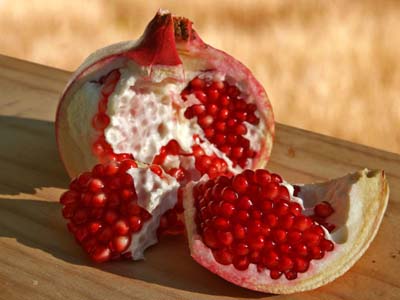Pomegranate

POMEGRANATE SKINS
The Pomegranate (Punica granatum) is a fruit-bearing deciduous shrub or small tree growing to 5–8 m tall. The pomegranate is native from Perisa and has been cultivated and naturalized over the whole Mediterranean region and the Caucasus since ancient times. It is widely cultivated throughout Azerbaijan, India, the drier parts of southeast Asia, Malaya, the East Indies, and tropical Africa. Introduced into Latin America and California by Spanish settlers in 1769, pomegranate is now cultivated mainly in the drier parts of California and Arizona for its fruits exploited commercially as juice products gaining in popularity since 2001.
The leaves are opposite or sub-opposite, glossy, narrow oblong, entire, 3–7 cm long and 2 cm broad. The flowers are bright red, 3 cm in diameter, with four to five petals (often more on cultivated plants). The fruit is between a lemon and a grapefruit in size, 5–12 cm in diameter with a rounded hexagonal shape, and has thick reddish skin and around 600 seeds. The seeds and surrounding pulp, ranging in colour from white to deep red, called arils, are edible; indeed, the fruit of the pomegranate is a berry. There are some cultivars which have been introduced that have a range of pulp colours such as purple.
Dye
The powdered rind (skin) have been used as a tannin mordant as well as a dye for peachy yellow with alum mordant, old gold with copper mordant, gray to moss green with iron mordant, yellow with tin mordant. Pomegranate rind was also used as a colorant for medieval illuminations. Light-fast and wash-fast.
The rinds are a waste product of the pulverized seeds. The age of the fruit affects the color of the dye: the less ripe the fruit, the greener the yellow.
Etymology
The name "pomegranate" derives from Latin pomum ("apple") and granatus ("seeded"). This has influenced the common name for pomegranate in many languages (e.g. German Granatapfel, seeded apple). The genus name Punica is named for the Phoenicians, who were active in broadening its cultivation, partly for religious reasons; consequently in classical Latin the fruit's name was malum punicum or malum granatum, where "malum" was broadly applied to many apple-like fruits. From the latter derived its Italian name melograno and the less used form of that melagrana. A separate, widespread root for "pomegranate" is the Egyptian and Semitic rmn. Attested in Ancient Egyptian, in Hebrew rimmôn, and in Arabic rummân, this root was brought by Arabic to a number of languages, including Portuguese (romã).
Pomegrante in history
The pomegranate originated from Caucasus and Persia. It has been cultivated in Azerbaijan, Georgia and the whole Mediterranean region for several millennia.
Carbonized exocarp of the fruit has been identified in Early Bronze Age levels of Jericho, as well as Late Bronze Age levels of Hala Sultan Tekke on Cyprus and Tiryns. A large, dry pomegranate was found in the tomb of Djehuty, the butler of Queen Hatshepsut; Mesopotamian cuneiform records mention pomegranates from the mid-Third millennium BCE onwards. It is also extensively grown in South China and in Southeast Asia, whether originally spread along the route of the Silk Road or brought by sea traders.
The ancient city of Granada in Spain was renamed after the fruit during the Moorish period. Spanish colonists later introduced the fruit to the Caribbean and Latin America, but in the English colonies it was less at home: "Don't use the pomegranate inhospitably, a stranger that has come so far to pay his respects to the English Quaker Peter Collinson wrote to the botanizing John Bartram in Philadelphia, 1762. "Plant it against the side of thy house, nail it close to the wall. In this manner it thrives wonderfully with us, and flowers beautifully, and bears fruit this hot year. I have twenty-four on one tree... Doctor Fothergill says, of all trees this is most salutiferous to mankind." The pomegranate had been introduced as an exotic to England the previous century, by John Tradescant the elder, but the disappointment that it did not set fruit there led to its repeated introduction to the American colonies, even New England. It succeeded in the South: Bartram received a barrel of pomegranates and oranges from a correspondent in Charleston, South Carolina, in 1764. Thomas Jefferson planted pomegranates at Monticello in 1771: he had them from George Wythe of Williamsburg.
